Service History
The two masted schooner
Peoria was built by master carpenter Alanson Gilmore over the winter of 1853-1854 at Black River, Ohio. The vessel was built for Lorain Ohio's postmaster, Charles H. Livingston and Captain E.P. Frink.
Peoria was initially used to take various bulk cargoes from ports on Lake Erie to Buffalo, New York, although it was stated that the vessel intended for trade on the upper lakes. Eventually, the vessel was used in the grain trade carrying grains from western ports like Chicago and Milwaukee to Buffalo and
Peoria was considered one of the best grain packets on the lakes.
Peoria's maximum capacity was 10,500 bushels.
Peoria suffered two accidents during the 1856 season. On the night of 17 July 1856, the vessel had collided with the schooner
North Carolina while upbound on Lake Erie. The
North Carolina required a tow back to Buffalo, while the
Peoria was only slightly damaged and maintained its course for Erie, Pennsylvania. During a gale on 8 November,
Peoria collided with the schooner
Wings of Wind while in the mouth of the Grand River, Port Island, Canada West.
Peoria lost its rigging and had several stanchions carried away at a cost of $100 in repairs.
In 1859, the
Peoria would be sold to new owners and have Chicago as its new homeport and transition to the lumber trade.
Peoria would carry lumber and shingles from northern ports on Lake Michigan like Grand Haven, Muskegon, and Green Bay down to Chicago. The vessel would occasionally still take cargos of grain and corn to Buffalo. In 1860
Peoria would be sold again to lumber Merchant Timothy Eastman of Chicago. Eastman founded the town of Eastmanville, Michigan the center of his families lumber and milling business. In 1861, Eastman had passed the
Peoria to his son Galen Eastman and Eastmanville was listed as its new homeport. Regardless, during this time the vessel was shifted back into the grain train carrying corn and wheat from Chicago to Oswego, Buffalo and Port Colborne, Ontario.
On the morning of 17 December 1861, four men were in a small fishing skiff taking in their fishing nets off the harbor at Grand Haven, Michigan.
Peoria was outbound when it had ran over the skiff, overturned it and shattered it, drowning three of the four fishermen. The fourth only survived by clinging to a piece of wreckage. The fisherman were all recent migrants from the Netherlands living in Grand Haven.
Peoria continued on to Chicago where the crew found the Chicago police department waiting for them at the dock. The then Captain Elsey and seven crew members were all arrested and transported back to Grand Haven for questioning. The Captain and mate were jailed and held over to appear in Circuit Court. It is unknown what penalties they received for the deaths. The vessel was sold again and returned to having Chicago as its homeport.
In October 1862
Peoria had its main boom carried away and a new one was procured at Detroit and the ship was back in service without much delay. Another incident on 17 June 1869,
Peoria ran into the barge
Trader at the Twelfth Street bridge in the Chicago River with minor damage to both vessels. Throughout this portion of
Peoria's career, the vessel was used primarily to carry lumber from northern ports on Lake Michigan to Chicago. On 9 June 1874,
Peoria lost its jibboom during a blow which temporarily delayed the ship. In 1875
Peoria was taken to the Miller Brothers' shipyard and placed in drydock to repair a persistent leak. On 1 June 1876,
Peoria collided with the schooner
Bessie Boalt when opposite the Chicago Lumber Market docks and lost its anchor stock. Although no repairs were undertaken later on 14 September,
Peoria began leaking badly while crossing the lake while lumber laden and was taken back to dry dock.
On 16 July 1877
Peoria was tied near the Lake Street Bridge in the Chicago River when the passing schooner
Avondale in tow of the tug
Monitor swept against the vessel and carried away the
Peoria's jibboom was carried away. On 20 September when entering the Burlington Slip to deliver lumber, the vessels cathead became hung up and was lost. At the beginning of October 1877, sailors had organized in Chicago to strike for an increase in wages. On 3 October a group of over thirty sailors rampaged on the docks along the Chicago River. At 3pm they came to the
Peoria laying at the foot of North Franklin Street and ordered the crew off. As the crowd approached, the captain cut the ship's lines and allowed the ship to drift to avoid the conflict. Later on 12 October
Peoria lost its staysail on the lake. On 16 October while approaching Chicago at night, the tugs
Monitor and
American Eagle began racing towards the
Peoria in competition for business to tow the schooner the rest of the way into the harbor. The two tugs collided gave a "hard bump" to
Peoria.
In July of 1878,
Peoria was on a return trip to Chicago with a cargo of lumber and was "leaking freely" and the crew had to work the pumps through the night to keep up with the leak. Once the ship was unloaded, it was immediately taken to dry dock. The vessel would return to service in August. Throughout the 1878 there was a series of small accidents. In August
Peoria had her martingale carried away while entering the lumber market docks, in October, its yawl was run over and shattered by a tug and on 6 November the ship arrived in Chicago with a split mainsail. In 1879 there was a strong unionization movement among sailors in Chicago, at the start of the season the owners of the
Peoria were still holding out and employing non-union sailors at a lower rate. It is unknown if the owners were able to either hire a non-union crew or if they eventually agreed to the unions demands, but the ship was delayed in starting its sailing season in 1879.
Later in September 1879, while the
Peoria was docking at the Chicago Lumber Market on 15 September, its spritsail yard was carried away and the line to the sail rain afoul in the propeller of the tug
Flossie Thielcke. On 9 September 1880
Peoria's problem with leaking continued and the vessel returned to the Miller Brothers' dry dock where it received a thorough re-caulking. The vessel returned to service on 13 September 1880.
On 16 November 1880,
Peoria ran aground in tremendous seas on an outer reef near the Baileys Harbor Lighthouse while loaded with lumber from Grand Haven. After several fruitless attempts to rescue the crew over the next day, Captain Lewis Lawson and the crew of the schooner
Conway succeeded in taking the crew off of the
Peoria. This storm later became known as the "Great Strom of 1880" or the "
Alpena Gale" due to the loss of the passenger steamer
Alpena in central Lake Michigan. In the fifty miles between Kewaunee and Death's Door Passage in Door County, twenty vessels were stranded with seven going ashore at Baileys Harbor alone including the
Peoria. By the end of October, the ship was reported in bad condition and was abandoned.
The wreckers Scofield & Co. of Chicago were contracted to send a tug and lighter to Baileys Harbor to recover the schooner's cargo of lumber for John Mason Loomis & Co. The wreck of the
Peoria was sold to Door County residents Captain George Bennett and Lincoln Erskin for $100 for scrapping. In 1881, Captain George Bennett made his way out to the wreck and discovered that it was sitting on a flat rock, he surmised that it could be salvaged and sail again. On 7 April Erskine and Bennett sold
Peoria to Scofield & Co. for $600 with the anticipating that they would repair, sell, or place the ship back in commission. On 22 April the tug
John Leathem went to Baileys Harbor to release the schooner, but the ship was found to be hard on. The tug
Tillson was dispatched a day later with a steam pump. Lighters were brought in and a portion of
Peoria's cargo of lumber was recovered. The wrecking tugs
Martin,
John Gregory, and
Leviathan came to the ship's aid attempts were made to life the ship with jackscrews to no avail. Next two scows were sunk on either side of the
Peoria and tied to the vessel with the intention of pumping them out and raise the schooner. This too was unsuccessful. On 14 May with the force of the three tugs the
Peoria was spun around and pulled into deeper water. The tug
John Gregory towed the
Peoria into Baileys Harbor at a cost of $1,000.
The next day 60,000 board-feet of lumber along with 300 ties were placed in
Peoria's hold to help float the vessel, but the schooner's decks remained about 1 1/2 feet underwater. The tug
John Leathem took the
Peoria in tow bound to Milwaukee.
Peoria arrived in Milwaukee on 18 May 1881 and immediately sank. A canvas jacket was added and a steam pump was placed aboard and
Peoria was raised again. The schooner was placed in drydock and a survey revealed that the vessel's bottom required significant repair. It was determined that
Peoria required a new keel and other general repairs at a cost of $1,200. The formerly wrecked
Peoria was relaunched on 2 June 1881 where it recommenced operating in the lumber trade with Milwaukee as its homeport.
On 22 July 1881
Peoria was caught in a storm off Port Clinton, Illinois and was forced to set anchor. At dark, the chain eventually parted and as the auxiliary anchor was being set, the deck load shifted and the schooner began to leak. The seas were running high and water was coming onto the deck and into the hold and the pumps were not keeping up. The steambarge
Francis Hinton came to the vessels aid, taking
Peoria in tow to Chicago where it was pumped out and repaired. On 16 September the vessel lost its flying jib during a trip to Sturgeon Bay. The schooner was forced into Milwaukee to seek shelter from a gale on 14 October. When
Peoria put up for winter in Ahnapee (Now Algoma) Wisconsin, the vessel received a new coat of black paint with red trim along with a general overhaul. Beginning in 1883 and throughout the rest of its career, the schooner would sometimes be the towed as a consort by the steambarge
Thomas H. Smith.
Peoria would be used to haul cedar ties from Red River and cedar posts from Cedar River, Michigan to Chicago for Leathem & Smith. At the end of July 1882 Leathem & Smith shut down their mill at Red River "for want of logs" and cedar cargo was picked up from from the company mill at Sturgeon Bay. With the diminishing cedar cargos,
Peoria began calling at other ports in northern Lake Michigan for the lumber trade.
Peoria had a friendly rivalry with another Leathem & Smith schooner
Westchester. The
Peoria landed two cargos of lumber in Chicago in twenty-two days while the
Westchester made two trips with lumber in eleven days - the fastest time ever made. By September 1883
Peoria required maintenance and the schooner had received a new mainmast boom, when the old boom was determined to be unsafe. During layup the ship received an overhaul in Sturgeon Bay from the waterline up. At this time
Peoria had made four round trips between Sturgeon Bay and Chicago in twenty days, it was recognized to be the fastest time ever made by any sailing vessel on Lake Michigan.
On 19 November 1885,
Peoria struck the outer breakwater at Chicago after being towed down from Sturgeon Bay by the
Thomas H. Smith. Only the captain and the mate were aboard because shortly before leaving Sturgeon Bay, the crew had struck for higher wages but were refused so they deserted the vessel. The
had dropped the Peoria off at Grosse Point, while attempting to enter Chicago harbor, the vessel was swept against the breakwater, carrying way its bowsprit, jibboom, headgear and its bulwarks were broken. The vessels stern swung around in the wind and started pounding against the pier and leaking badly. Peoria was towed in by the tug Shields. Later Captain Boyd of the Thomas H. Smith made a statement to the newspapers completely refuting the accident and stating that the Peoria was undamaged and there were no repairs were made after such great damage.
On 19 November 1886 the Leathem & Smith sawmill at Sturgeon Bay was shut down. The shingle machines were dismantled and placed aboard Peoria to take to Leathem on the west side of Green bay and operated by the winter lumber camp crews. The vessel was stripped down to a barge on 21 November so it could be used to transfer horses, cattle and machinery from Sturgeon Bay to Leathem and was towed by the tug John Leathem. The vessel would be restored to its original outfit for the 1887 season. On 9 May 1887 Peoria collided with the steambarge City of Nicollet on Green Bay. The City of Nicollet had its smokestack knocked over and its cabin was swept overboard. Peoria suffered significant damage to its bow and headgear and sailed to be drydocked in Chicago the next day for $1,500. Leathem & Smith settled on a compromise with the owners of the steambarge and they accepted $150 for damages.
Peoria was overhauled at the Chicago Dry Dock Company again in May 1889. On 19 November 1892 while being towed by the tug Knights Templar on the Milwaukee River, the wind caught the Peoria and swung the schooner into the stern of the steamer R.P. Fitzgerald which was making a U-turn in the river. Peoria was towed alongside the Milwaukee Gas Company dock. Its bow was split open down the stem from the force of the collision which caused the ship to sink up to its deck. The steamer was taken to a drydock to have a new propeller installed. It was too stormy to recover the Peoria and on 21 November Knights Templar attempted to move Peoria to a dock where its deck load of lumber could be removed. While in the draw of the Broadway Street Bridge, the tug's machinery became disabled and the schooner was abandoned. The tug Simpson later moved Peoria back to the gas company dock to avoid blocking navigation on the river. It was debated whether or not Peoria should be repaired or written off as a total loss. The ship was transferred to the dry dock in late November. Throughout the 1890's Peoria would be used in the coal trade. The vessel was sold in 1899 and its entire outfit was removed and placed on the larger schooner Maize. The vessels next and final orders would replace the outfit.
Final Voyage
On 10 November 1901, Peoria was bound from Charlevoix with a cargo of 140,000 feet of hardwood lumber when it came into Baileys harbor to wait out a storm. The ships starboard anchor was dropped and during the night the anchor began to drag so the port anchor was deployed. The wind and the waves were so ferocious that the two anchors failed to hold the Peoria and the schooner went up on the beach near the range lights. The Baileys Harbor lifesaving station rescued the crew of six men. The upper part of the vessel broke up badly and the lumber on the deck was tossed on the beach. The vessel from the waterline held fast in the sediment and did not break up. On 12 November the crew began stripping the Peoria. They threatened to libel the cargo and outfit for their lost property and unpaid wages, this dispute was settled for an unknown amount. This was twenty one years later and nearly the same vicinity as where the ship first wrecked while waiting out the "Alpena Gale" in 1880.
Today
The wreck today still lies mostly buried in 7 feet of water just northeast from the entrance to Baileys Harbor Marina. It lies mostly intact in the sandy bottom and is embedded in the sand up to its deck shelf. The hull is mostly still extant but buried and the furthest extent of the vessels bow, and stern remain buried beneath the sand. It is also likely that many artifacts remain still buried in the sand.
 Schooner.JPG)
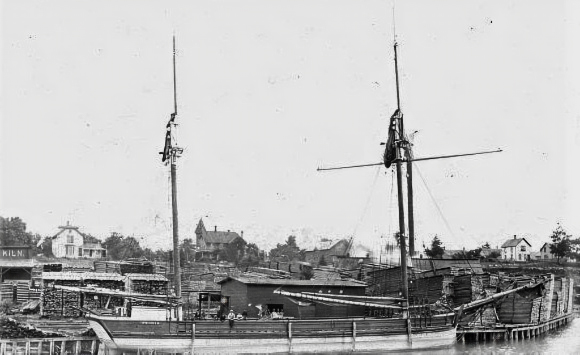
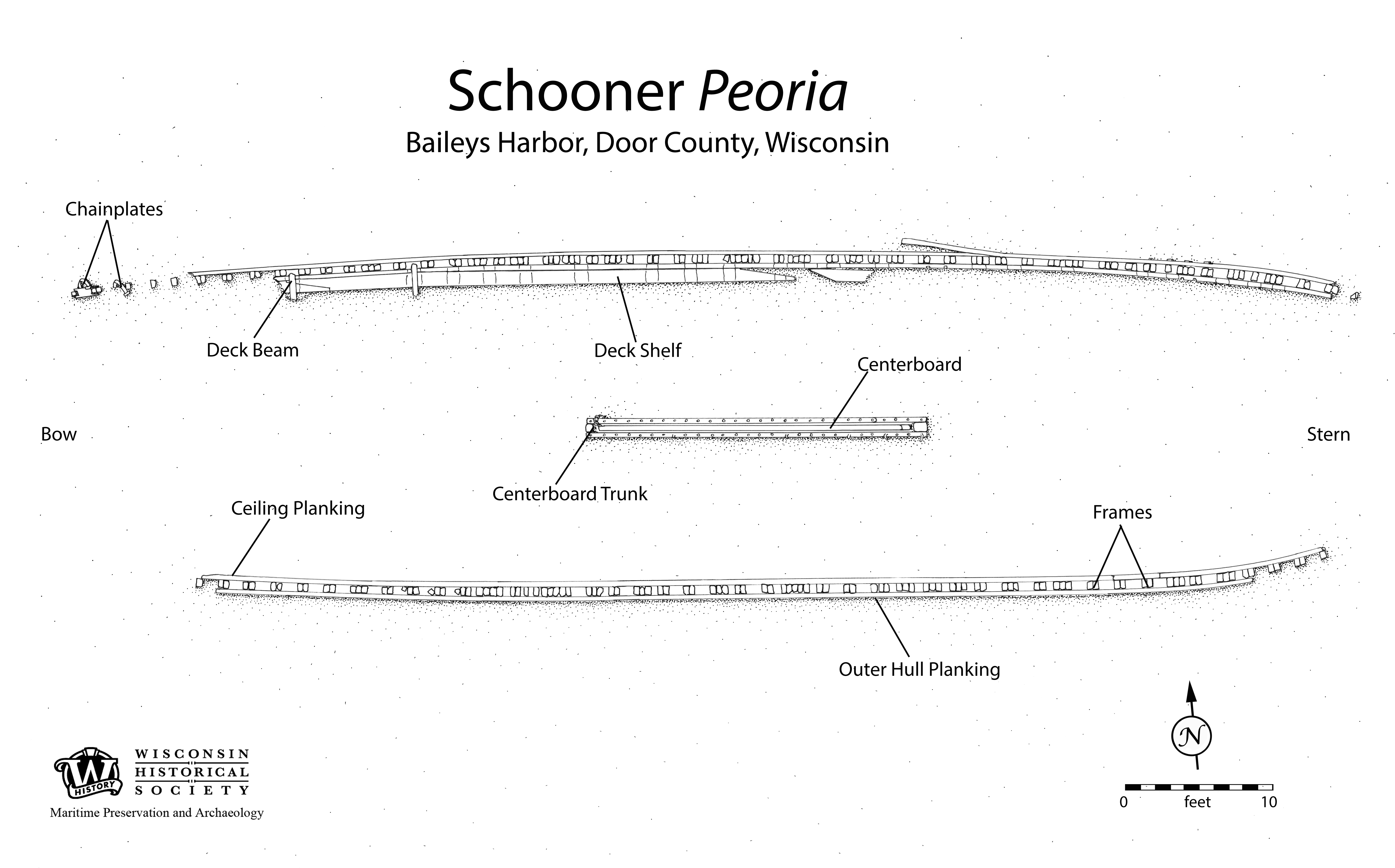
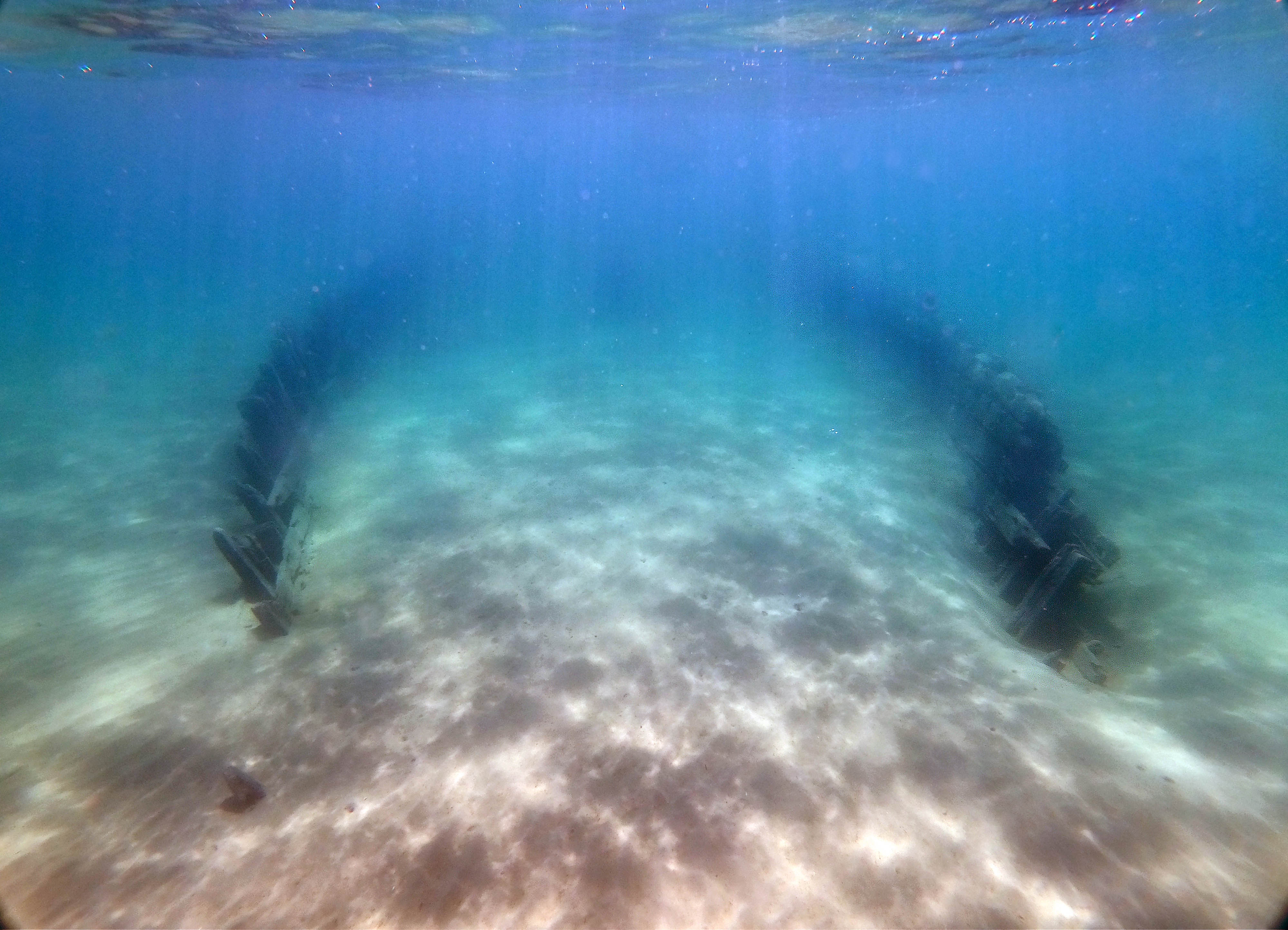
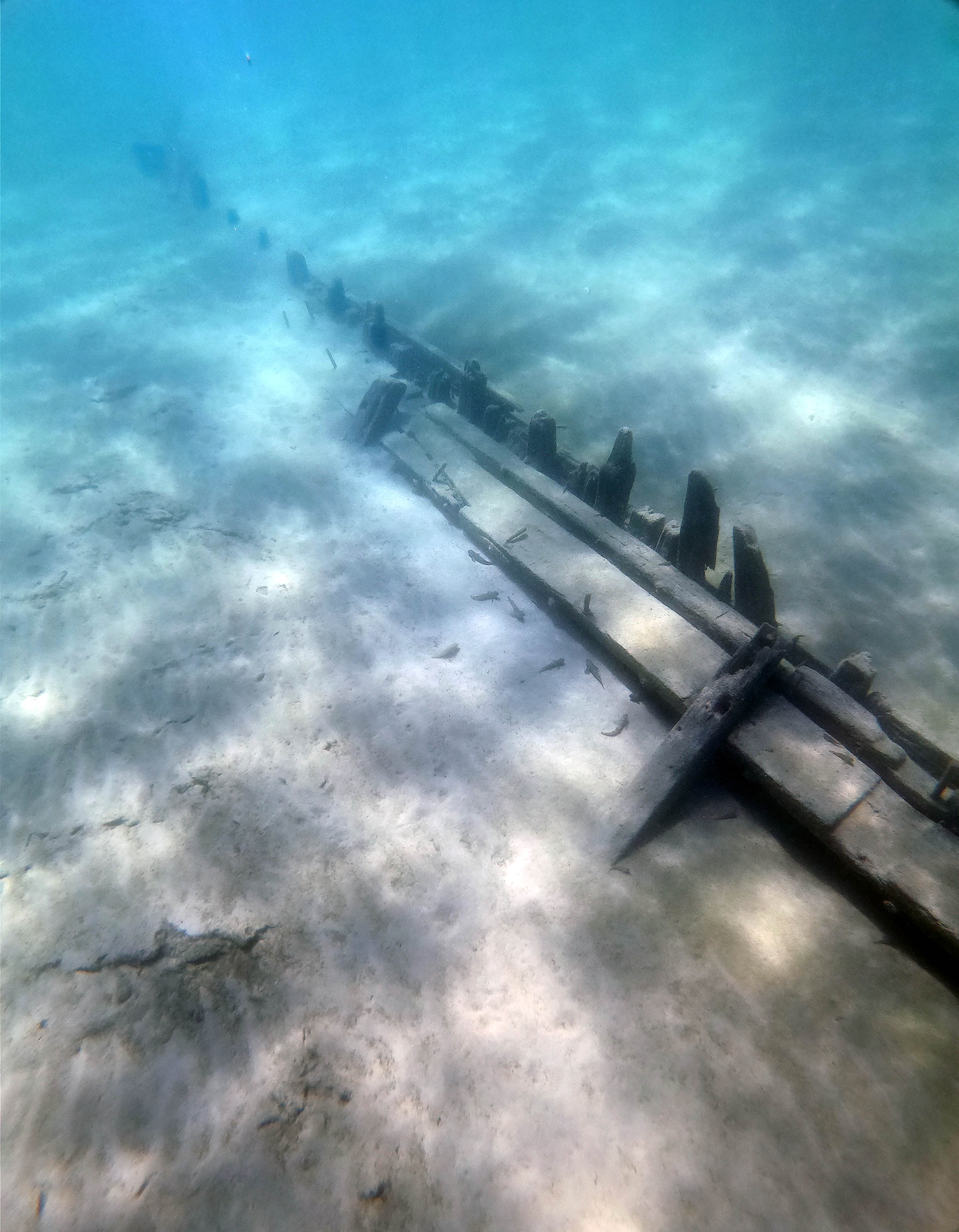
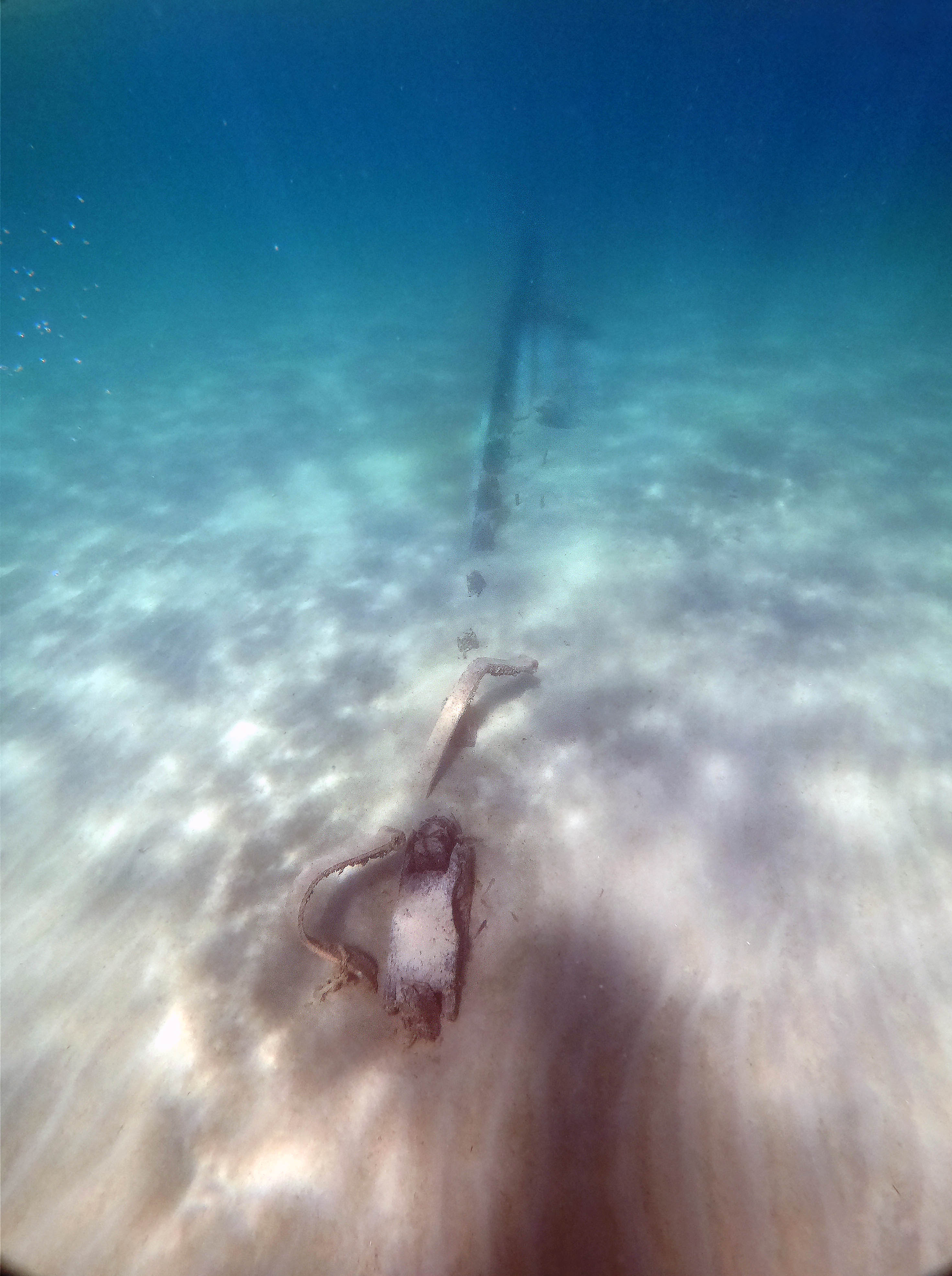
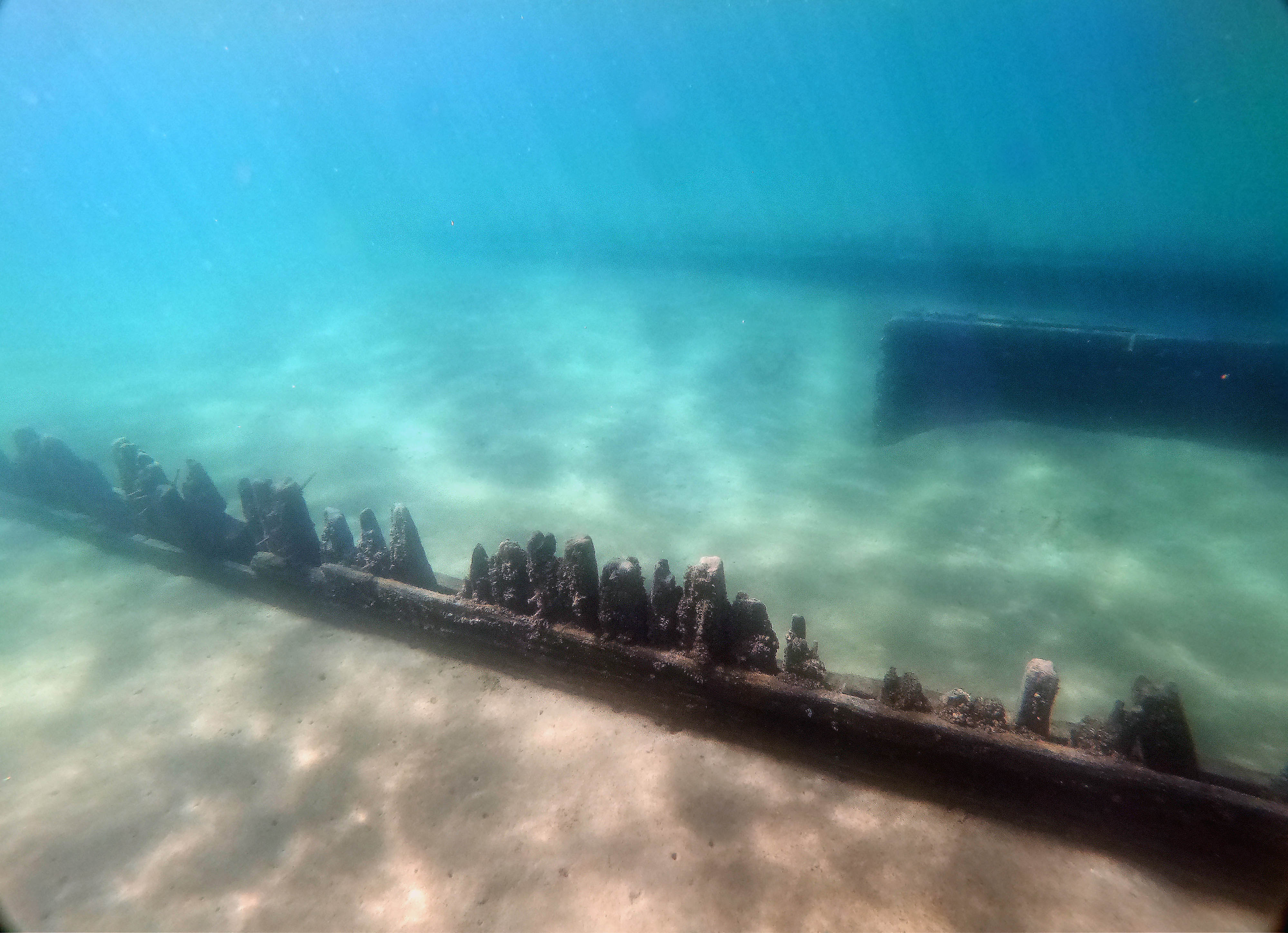
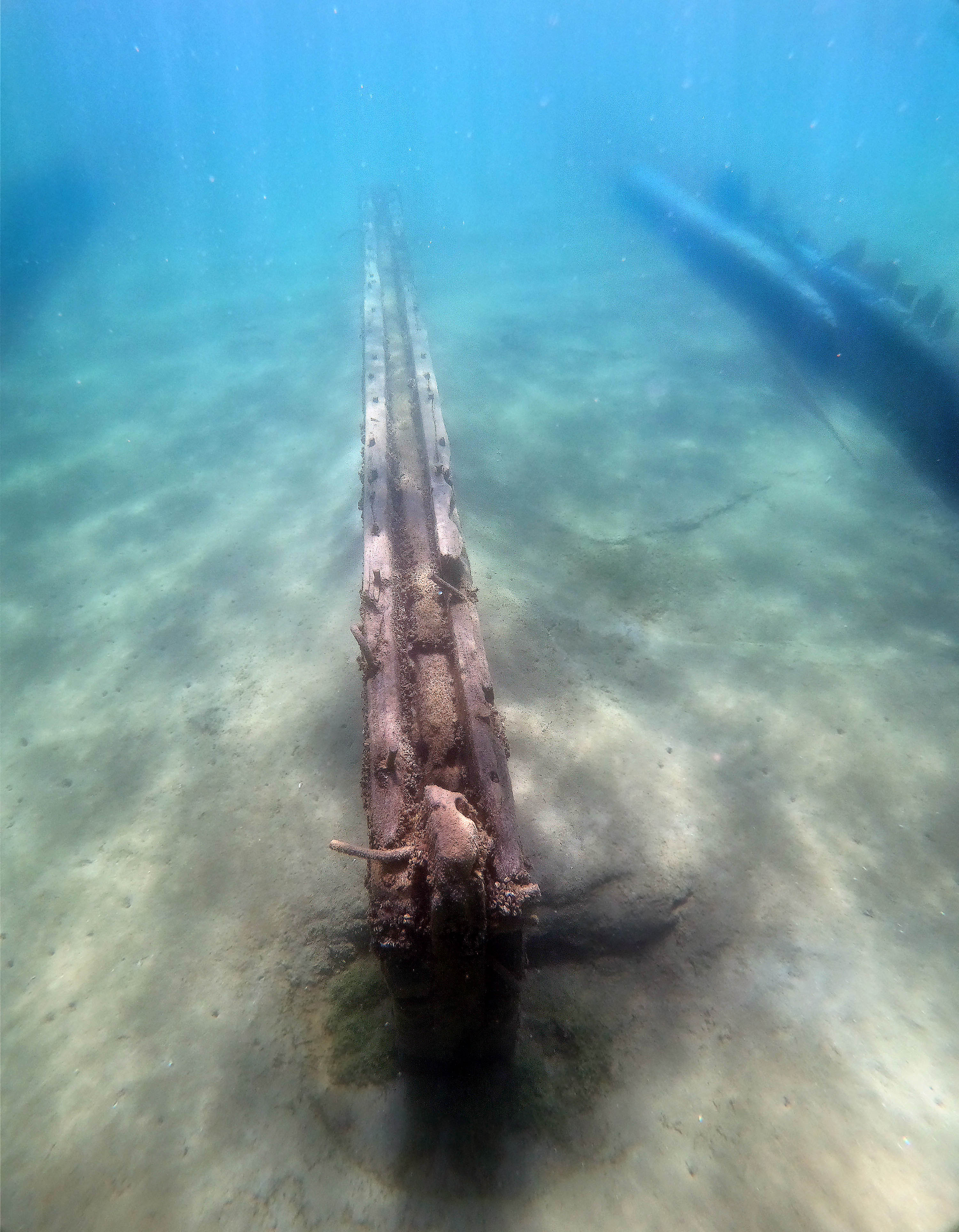
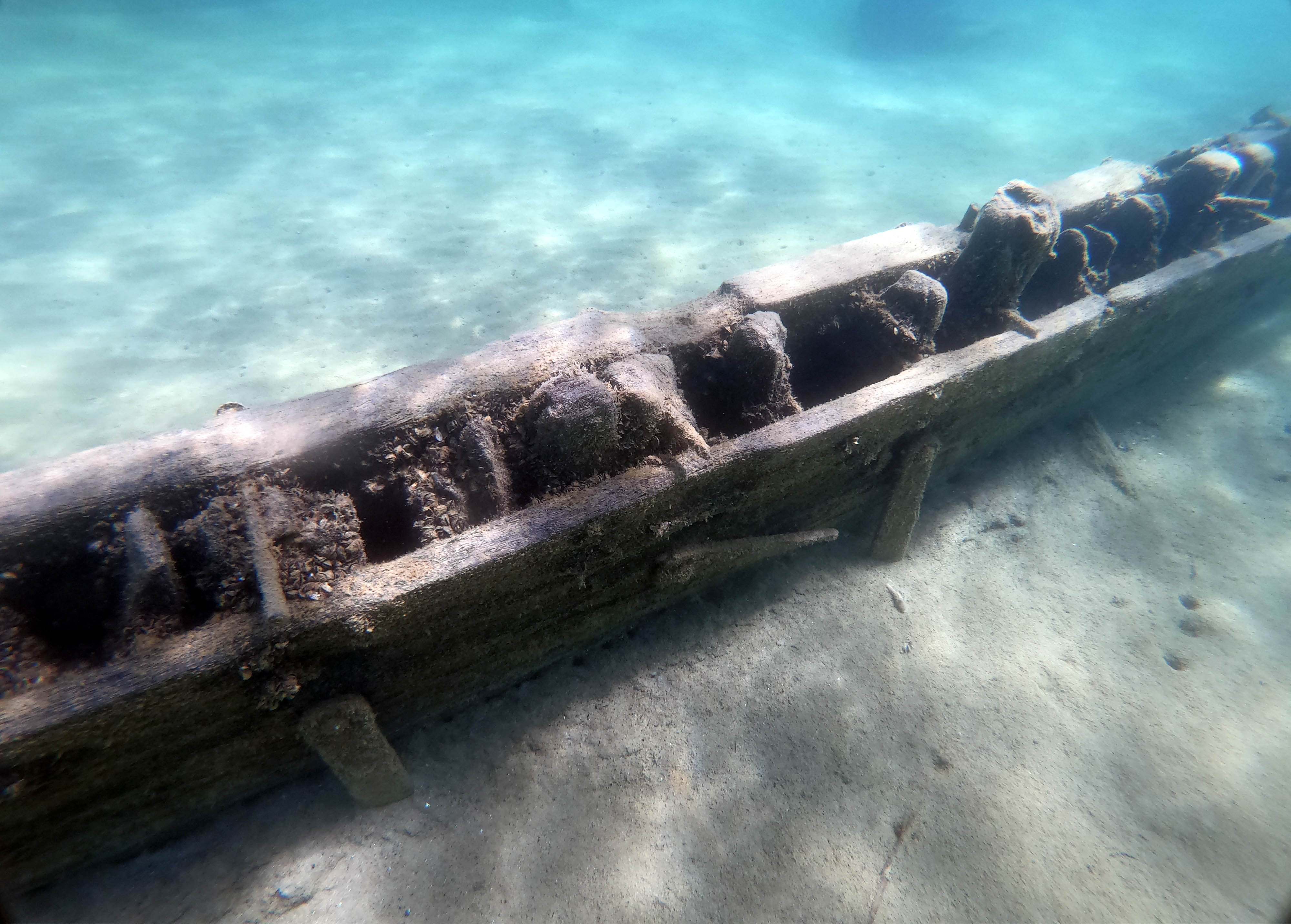
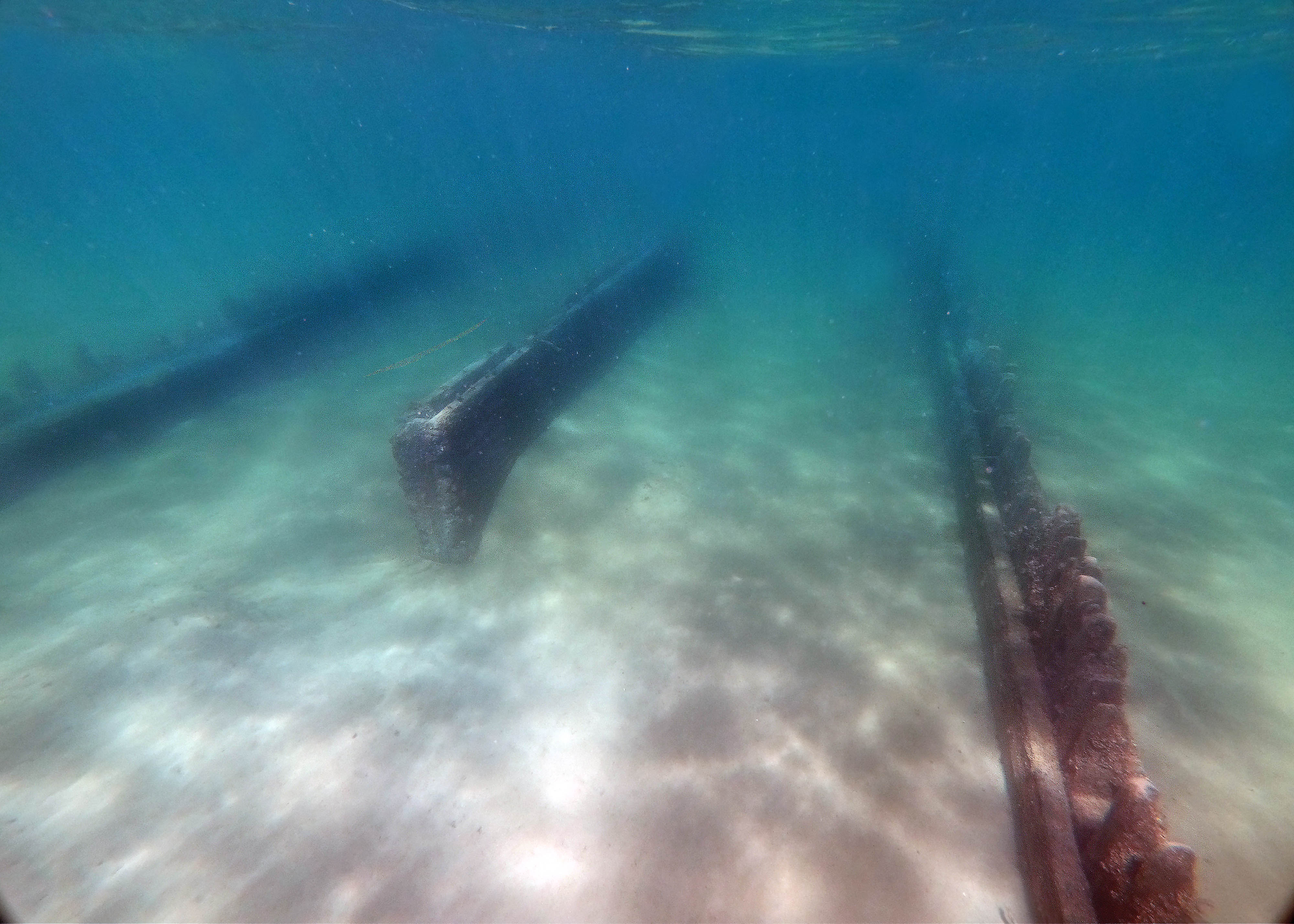

 Confirmed Location
Confirmed Location
 Unconfirmed location
Unconfirmed location